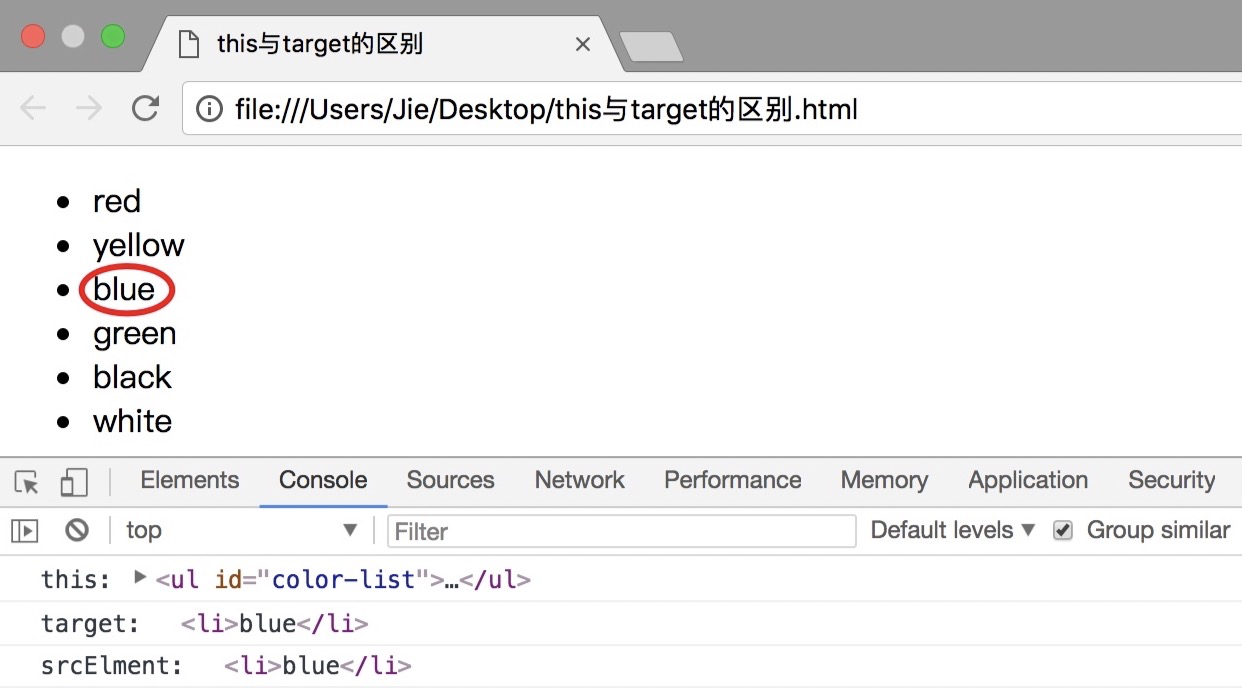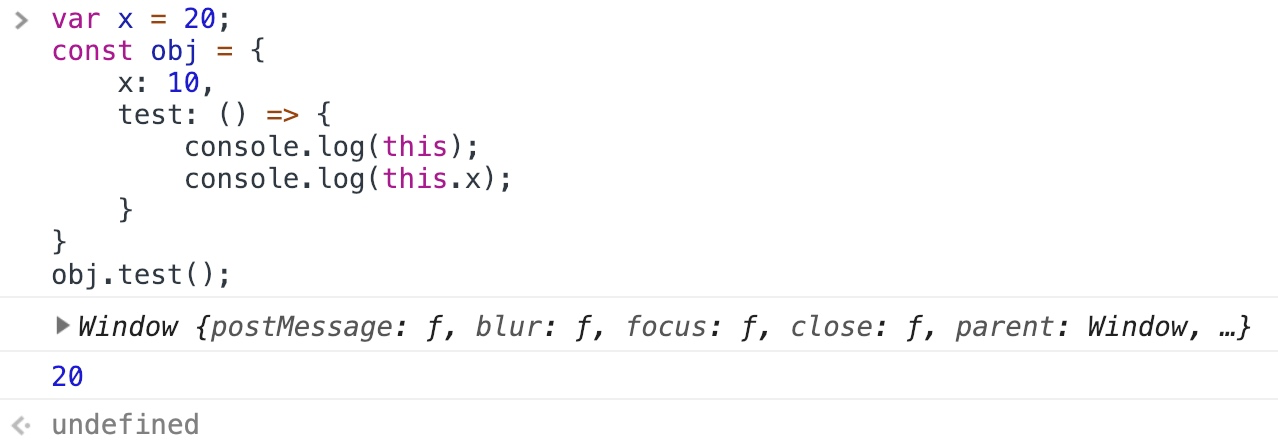经典真题
- this 的指向哪几种 ?
this 指向总结
this 关键字是一个非常重要的语法点。毫不夸张地说,不理解它的含义,大部分开发任务都无法完成。
this 可以用在构造函数之中,表示实例对象。除此之外,this 还可以用在别的场合。但不管是什么场合,this 都有一个共同点:它总是返回一个对象(不考虑严格模式)。
关于 this 的指向,有一种广为流传的说法就是“谁调用它,this 就指向谁”。
这样的说法没有太大的问题,但是并不是太全面。总结起来,this 的指向规律有如下几条:
- 在函数体中,非显式或隐式地简单调用函数时,在严格模式下,函数内的 this 会被绑定到 undefined 上,在非严格模式下则会被绑定到全局对象 window/global 上。
- 一般使用 new 方法调用构造函数时,构造函数内的 this 会被绑定到新创建的对象上。
- 一般通过 call/apply/bind 方法显式调用函数时,函数体内的 this 会被绑定到指定参数的对象上。
- 一般通过上下文对象调用函数时,函数体内的 this 会被绑定到该对象上。
- 在箭头函数中,this 的指向是由外层(函数或全局)作用域来决定的。
当然,真实环境多种多样,下面我们就来根据实战例题逐一梳理。
全局环境中的 this
例题 1:
1 | function f1() { |
这种情况相对简单、直接,函数在浏览器全局环境下被简单调用,在非严格模式下 this 指向 window,在通过 use strict 指明严格模式的情况下指向 undefined。
虽然上面的题目比较基础,但是需要注意上面题目的变种,例如
例题 2:
1 | const foo = { |
这里的 this 仍然指向 window。虽然 fn 函数在 foo 对象中作为该对象的一个方法,但是在赋值给 fn1 之后,fn1 仍然是在 window 的全局环境下执行的。因此上面的代码仍然会输出 window 和 undefined。
还是上面这道题目,如果改成如下的形式
例题 3:
1 | const foo = { |
这时,this 指向的是最后调用它的对象,在 foo.fn( ) 语句中,this 指向的是 foo 对象。
上下文对象调用中的 this
例题 4:
1 | const student = { |
在上面的代码中,this 指向当前的对象 student,所以最终会返回 true。
当存在更复杂的调用关系时,如以下代码中的嵌套关系,this 将指向最后调用它的对象,例如
例题 5:
1 | const student = { |
在上面的代码中,this 会指向最后调用它的对象,因此输出的是 zhangxiaosan。
至此,this 的上下文对象调用已经介绍得比较清楚了。我们再来看一道比较高阶的题目
例题 6:
1 | const o1 = { |
答案是 o1、o1、undefined。
这里主要讲一下为什么第三个是 undefined。这里将 o1.fn 赋值给了 fn,所以 fn 等价于 *function () { return this.text; }*,然后该函数在调用的时候,是直接 fn( ) 的形式调用的,并不是以对象的形式,相当于还是全局调用,指向 window,所以打印出 undefined。
this 指向绑定事件的元素
DOM 元素绑定事件时,事件处理函数里面的 this 指向绑定了事件的元素。
这个地方一定要注意它和 target 的区别,target 是指向触发事件的元素。
示例如下:
1 | <ul id="color-list"> |
1 | // this 是绑定事件的元素 |
当我点击如下位置时打印出来的信息如下:
有些时候我们会遇到一些困扰,比如在 div 节点的事件函数内部,有一个局部的 callback 方法,该方法被作为普通函数调用时,callback 内部的 this 是指向全局对象 window 的
例如:
1 | <div id="div1">我是一个div</div> |
1 | window.id = 'window'; |
此时有一种简单的解决方案,可以用一个变量保存 div 节点的引用,如下:
1 | window.id = 'window'; |
改变 this 指向
1. call、apply、bind 方法修改 this 指向
由于 JavaScript 中 this 的指向受函数运行环境的影响,指向经常改变,使得开发变得困难和模糊,所以在封装 sdk 或者写一些复杂函数的时候经常会用到 this 指向绑定,以避免出现不必要的问题。
call、apply、bind 基本都能实现这一功能,起到确定 this 指向的作用
Function.prototype.call( )
call 方法可以指定 this 的指向(即函数执行时所在的的作用域),然后再指定的作用域中,执行函数。
1 | var obj = {}; |
上面代码中,全局环境运行函数 f 时,this 指向全局环境(浏览器为 window 对象);
call 方法可以改变 this 的指向,指定 this 指向对象 obj,然后在对象 obj 的作用域中运行函数 f。
call 方法的参数,应该是对象 obj,如果参数为空或 null、undefind,则默认传参全局对象。
1 | var n = 123; |
上面代码中,a 函数中的 this 关键字,如果指向全局对象,返回结果为 123。
如果使用 call 方法将 this 关键字指向 obj 对象,返回结果为 456。可以看到,如果 call 方法没有参数,或者参数为 null 或 undefined,则等同于指向全局对象。
如果 call 传参不是以上类型,则转化成对应的包装对象,然后传入方法。
例如,5 转成 Number 实例,绑定 f 内部 this
1 | var f = function () { |
call 可以接受多个参数,第一个参数是 this 指向的对象,之后的是函数回调所需的参数。
1 | function add(a, b) { |
call 方法的一个应用是调用对象的原生方法。
1 | var obj = {}; |
上面代码中 hasOwnProperty 是 obj 继承来的方法,用来判断对象是否包含自身特点(非继承)属性,但是 hasOwnProperty 并不是保留字,如果被对象覆盖,会造成结果错误。
call 方法可以解决这个问题,它将 hasOwnProperty 方法的原始定义放到 obj 对象上执行,这样无论 obj 上有没有同名方法,都不会影响结果。
Function.prototype.apply( )
apply 和 call 作用类似,也是改变 this 指向,然后调用该函数,唯一区别是 apply 接收数组作为函数执行时的参数。语法如下:
1 | func.apply(thisValue, [arg1, arg2, ...]) |
apply 方法的第一个参数也是 this 所要指向的那个对象,如果设为 null 或 undefined,则等同于指定全局对象。
第二个参数则是一个数组,该数组的所有成员依次作为参数,传入原函数。
原函数的参数,在 call 方法中必须一个个添加,但是在 apply 方法中,必须以数组形式添加。
1 | function f(x, y){ |
利用这一特性,可以实现很多小功能。比如,输出数组的最大值:
1 | var a = [24,30,2,33,1] |
还可以将数组中的空值,转化成 undefined。
通过 apply 方法,利用 Array 构造函数将数组的空元素变成 undefined。
1 | var a = ['a',,'b']; |
空元素与 undefined 的差别在于,数组的 forEach 方法会跳过空元素,但是不会跳过 undefined。因此,遍历内部元素的时候,会得到不同的结果。
1 | var a = ['a', , 'b']; |
配合数组对象的 slice 方法,可以将一个类似数组的对象(比如 arguments 对象)转为真正的数组。
1 | Array.prototype.slice.apply({0: 1, length: 1}) // [1] |
上面代码的 apply 方法的参数都是对象,但是返回结果都是数组,这就起到了将对象转成数组的目的。
从上面代码可以看到,这个方法起作用的前提是,被处理的对象必须有 length 属性,以及相对应的数字键。
Function.prototype.bind( )
bind 用于将函数体内的 this 绑定到某个对象,然后返回一个新函数
1 | var d = new Date(); |
报错是因为 d.getTime 赋值给 print 后,getTime 内部的 this 指向方式变化,已经不再指向 date 对象实例了。
解决方法:
1 | var print = d.getTime.bind(d); |
bind 接收的参数就是所要绑定的对象
1 | var counter = { |
绑定到其他对象
1 | var counter = { |
bind 还可以接收更多的参数,将这些参数绑定到原函数的参数
1 | var add = function (x, y) { |
上面代码中,bind 方法除了绑定 this 对象,还将 add 函数的第一个参数 x 绑定成 5,然后返回一个新函数 newAdd,这个函数只要再接受一个参数 y 就能运行了。
如果 bind 方法的第一个参数是 null 或 undefined,等于将 this 绑定到全局对象,函数运行时 this 指向顶层对象(浏览器为 window)。
1 | function add(x, y) { |
上面代码中,函数 add 内部并没有 this,使用 bind 方法的主要目的是绑定参数 x,以后每次运行新函数 plus5,就只需要提供另一个参数 y 就够了。
而且因为 add 内部没有 this,所以 bind 的第一个参数是 null,不过这里如果是其他对象,也没有影响。
bind 方法有一些使用注意点。
(1)每一次返回一个新函数
bind 方法每运行一次,就返回一个新函数,这会产生一些问题。比如,监听事件的时候,不能写成下面这样。
1 | element.addEventListener('click', o.m.bind(o)); |
上面代码中,click 事件绑定 bind 方法生成的一个匿名函数。这样会导致无法取消绑定,所以,下面的代码是无效的。
1 | element.removeEventListener('click', o.m.bind(o)); |
正确的方法是写成下面这样:
1 | var listener = o.m.bind(o); |
(2)结合回调函数使用
回调函数是 JavaScript 最常用的模式之一,但是一个常见的错误是,将包含 this 的方法直接当作回调函数。解决方法就是使用 bind 方法,将 counter.inc 绑定 counter。
1 | var counter = { |
上面代码中,callIt 方法会调用回调函数。这时如果直接把 counter.inc 传入,调用时 counter.inc 内部的 this 就会指向全局对象。使用 bind 方法将 counter.inc 绑定 counter 以后,就不会有这个问题,this 总是指向 counter。
还有一种情况比较隐蔽,就是某些数组方法可以接受一个函数当作参数。这些函数内部的 this 指向,很可能也会出错。
1 | var obj = { |
上面代码中,obj.print 内部 this.times 的 this 是指向 obj 的,这个没有问题。
但是,forEach 方法的回调函数内部的 this.name 却是指向全局对象,导致没有办法取到值。稍微改动一下,就可以看得更清楚。
1 | obj.print = function () { |
解决这个问题,也是通过 bind 方法绑定 this。
1 | obj.print = function () { |
(3)结合 call 方法使用
利用 bind 方法,可以改写一些 JavaScript 原生方法的使用形式,以数组的 slice 方法为例。
1 | [1, 2, 3].slice(0, 1) // [1] |
上面的代码中,数组的 slice 方法从 [1, 2, 3] 里面,按照指定位置和长度切分出另一个数组。这样做的本质是在 [1, 2, 3] 上面调用 Array.prototype.slice 方法,因此可以用 call 方法表达这个过程,得到同样的结果。
call 方法实质上是调用 Function.prototype.call 方法,因此上面的表达式可以用 bind 方法改写。
1 | var slice = Function.prototype.call.bind(Array.prototype.slice); |
上面代码的含义就是,将 Array.prototype.slice 变成 Function.prototype.call 方法所在的对象,调用时就变成了 Array.prototype.slice.call。类似的写法还可以用于其他数组方法。
1 | var push = Function.prototype.call.bind(Array.prototype.push); |
如果再进一步,将 Function.prototype.call 方法绑定到 Function.prototype.bind 对象,就意味着 bind 的调用形式也可以被改写。
1 | function f() { |
上面代码的含义就是,将 Function.prototype.bind 方法绑定在 Function.prototype.call 上面,所以 bind 方法就可以直接使用,不需要在函数实例上使用。
2. 箭头函数的 this 指向
当我们的 this 是以函数的形式调用时,this 指向的是全局对象。
不过对于箭头函数来讲,却比较特殊。箭头函数的 this 指向始终为外层的作用域。
先来看一个普通函数作为对象的一个方法被调用时,this 的指向,如下:
1 | const obj = { |
可以看到,普通函数作为对象的一个方法被调用时,this 指向当前对象。
在上面的例子中,就是 obj 这个对象,this.x 的值为 10。
接下来是箭头函数以对象的方式被调用的时候的 this 的指向,如下:
1 | var x = 20; |
这里的结果和上面不一样,this 打印出来为 { },而 this.x 的值为 undefined。
为什么呢?
实际上刚才我们有讲过,箭头函数的 this 指向与普通函数不一样,它的 this 指向始终是指向的外层作用域。所以这里的 this 实际上是指向的全局对象。
如果证明呢?
方法很简单,将这段代码放入浏览器运行,在浏览器中用 var 所声明的变量会成为全局对象 window 的一个属性,如下:
接下来我们再来看一个例子,来证明箭头函数的 this 指向始终是指向的外层作用域。
1 | var name = "JavaScript"; |
接下来我们将 i 函数修改为箭头函数,如下:
1 | var name = "JavaScript"; |
最后需要说一点的就是,箭头函数不能作为构造函数,如下:
1 | const Test = (name, age) => { |
真题解答
- this 的指向哪几种 ?
参考答案:
总结起来,this 的指向规律有如下几条:
- 在函数体中,非显式或隐式地简单调用函数时,在严格模式下,函数内的 this 会被绑定到 undefined 上,在非严格模式下则会被绑定到全局对象 window/global 上。
- 一般使用 new 方法调用构造函数时,构造函数内的 this 会被绑定到新创建的对象上。
- 一般通过 call/apply/bind 方法显式调用函数时,函数体内的 this 会被绑定到指定参数的对象上。
- 一般通过上下文对象调用函数时,函数体内的 this 会被绑定到该对象上。
- 在箭头函数中,this 的指向是由外层(函数或全局)作用域来决定的。
__END__

